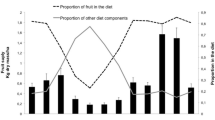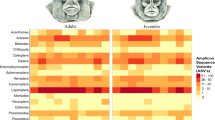Abstract
The feeding preferences of howler monkeys at their northernmost distribution in the Neotropics are reported for an annual cycle. A remarkable selectivity for 27 species representing 15 families was observed. The Moraceae and Lauraceae plant families were the most important in the diet. The howlers spent an almost equal proportion of their feeding time eating leaves and fruit, and displayed a marked preference for young leaves and mature fruit. The consumption of different plant parts was markedly seasonal and the howlers’ ranging behavior was closely associated with the availability of young leaves and mature fruit. Their home range was unusually large (ca. 60 ha) for howlers and the food species exploited occur at very low densities (93%, ≤ 4 ind/ha). They chose food items richer in protein and energy. Alkaloid compounds, present in some of the leaves, play a secondary role in their dietary selectivity.
Similar content being viewed by others
References
Altmann, J. (1974). Observational study of behavior: Sampling methods.Behaviour 69(3–4): 227–267.
Bernstein, I. (1964). A field study of the activities of howler monkeys.Anim. Behav. 12: 92–97.
Carabias, J. (1980).Análisis de la Vegetarión de la Selva Alla Perennifolia y Communidades Derivadas de esta en una Zona Cálido hÚmeda de México. Los Tuxtlas, Thesis, University of Mexico.
Carpenter, C. R. (1964). A field study of the behavior and social relations of howling monkeys (Alouatta palliata). Comp. Psychol. Monogr. 10(2): 81–168.
Coelho, A. M., Bramblett, C. A., Quick, L. B., and Bramblett, S. A. (1976). Resource availability and population density in primates: A socio-bioenergetic analysis of energy budgets of Guatemalan howler and spider monkeys.Primates 17: 63–80.
Collias, H., and Southwick, C. A. (1952). Field study of population density and social organization in howling monkeys.Am. Phil. Soc. 92:143–156.
Chivers, D. J. (1969). On the daily behaviour and spacing of howling monkey groups.Folia primatol. 10:48–102.
Estrada, A. (1982). Survey and census of howler monkeys in the rain forest of Los Tuxtlas, Veracruz, Mexico.Am. J. Primatol. 2(4): 363–372.
Flores, J. S. (1971).Estudio de la Vegetation del Cerro El Vigía de la Estación de Biología Tropical “Los Tuxtlas,” Veracruz, Thesis, University of Mexico.
Glander, K. (1975).Habitat and Resource Utilization: An Ecological View of Social Organization in Mantled Howling Monkeys, Ph.D dissertation, University of Chicago, Chicago.
Glander, K. (1978). Howling monkey feeding behavior and plant secondary compounds: A study of strategies. In Montgomery, G. G. (ed.),The Ecology of Arboreal Folivores, Smithsonian Press, Washington, D.C.
Glander, K. (1981). Feeding patterns in mantled howling monkeys. In Kamil, A.C., and Sargent, T. D. (eds.),Foraging Behavior. Ecological, Ethological and Psychological Approaches, Gartland STPM Press, New York.
Gaulin, J. C. S., and Gaulin C. K. (1982). Behavioral ecology ofAlouatta seniculus in Andean cloud forest.Int, J. Primatol. 3(1): 1–32.
Janzen, D. (1978). Complications in interpreting the chemical defenses of trees against tropical arboreal plant-eating vertebrates. In Montgomery, G. G. (ed.),The Ecology of Arboreal Folivores, Smithsonian Press, Washington, D.C.
Klein, L., and Klein, D. (1973). Neotropical primates: Aspects of habitat usage, population density and regional distribution in La Macarena, Colombia. In Thorington, R. W., and Heltne, P. G. (eds.).Neotropical Primates: Field Studies and Conservation, National Academy of Sciences, Washington, D.C.
McKey, D. (1975). The ecology of coevolved seed dispersal systems. In Gilbert, L. E., and Raven, P. H. (eds.),Coevolution of Animals and Plants, University of Texas Press, Austin.
McKey, D. (1979). The distribution of secondary compounds with plants. In Rosenthal, G. A., and Janzen, D. (eds.),Herbivores: Their Interactions with Secondary Plant Metabolites, Academic Press, New York.
Milton, K. (1975). Urine rubbing behavior in the mantled howler monkey.Folia primatol. 23: 105–122.
Milton, K. (1977).The Foraging Strategy of the Howler Monkey in the Tropical Forest of Barro Colorado Island, Panama, Ph.D dissertation, New York University.
Milton, K. (1978). Behavioral adaptations to leaf-eating in the mantled howling monkey. In Montogomery, G. G. (ed.),The Ecology of Arboreal Folivores, Smithsonian Press, Washington, D.C.
Milton, K. (1979). Factors influencing leaf choice by howler monkeys: A test of some hypotheses of food selection by generalist herbivores.Am. Nat. 114(3): 262–278.
Milton, K. (1980).The Foraging Strategy of Howler Monkeys: A Study in Primate Economics, Columbia University Press, New York.
Milton, K., Van Soest, P. J., and Robertson, J. B. (1980). Digestive efficiencies of wild howler monkeys.Physiol. Zool. 53(4): 402–409.
Miranda, F., and Hernandez, E. (1963). Los tipos de vegetación de Mexico y su clasificación.Bol. Soc. Bot. Méx. 29: 29–179.
Montgomery, G. G., and Sunquist, M. E. (1978). Habitat selection and use by two-toed and three-toed sloths. In Montgomery, G. G. (ed.),The Ecology of Arboreal Folivores, Smithsonian Press, Washington, D.C.
Neville, M. K. (1972a). The population structure of red howler monkeys (Alouatta seniculus) in Trinidad, Venezuela.Folia primatol. 17: 56–86.
Neville, M. K. (1972b). Social relations within troops of red howler monkeys (Alouatta seniculus).Folia primatol. 18:47–77.
Opler, P. A. (1978). Interactions of plant life history components as related to arboreal herbivory. In Montgomery, G. G. (ed.),The Ecology of Arboreal Folivores, Smithsonian Press, Washington, D.C.
Penninton, T., and Sarukhan, J. (1968).Arboles Tropicales de México, Inst. Nal. Invest. Forest., SAG, Mexico City.
Pielou, E. C. (1974).Ecological Diversity, John Wiley and Sons, New York.
Pielou, E.C. (1977).Mathematical Ecology, John Wiley and Sons, New York.
Pinero, D., Sarukhan, J., and Gonzales, E. (1977). Estudios demograficos en plantas.Astrocaryum mexicanum Liebm. I. Estructure de las problaciones.Bol. Soc. Bot. Méx. 37:69–118.
Pope, B. L. (1966). Biology of the howler monkey (Alouatta caraya) population characteristicsBiblio. Primatol. 7: 13–20.
Richard, A. (1970). A comparative study of the activity patterns and behavior ofAlouatta villosa andAteles geoffroyi.Folia primatol. 12: 241–263.
Richard, A. (1978). Variability in the feeding behavior of a Malagasy prosimian,Propithecus verreauxi: Lemuriformes. In Montgomery, G. G. (eds.),The Ecology of Arboreal Folivores, Smithsonian Press, Washington, D.C.
Rockwood, L. L. (1975). The effects of seasonality on foraging in two species of leaf-cutter ants (Atta) in Guanacaste province, Costa Rica.Biotropica 7: 176–193.
Rockwood, L. L. (1976). Plant selection and foraging patterns in two species of leaf-cutting ants (Atta).Ecology 57:48–61.
Rudran, R.(1978). Intergroop dietary comparisons and folivorous tendencies of two groups of blue monkeys (Cercopithecus mitis stuhlmanni). In Montgomery, G. G. (ed.),The Ecology of Arboreal Folivores, Smithsonian Press, Washington, D.C.
Rudran, R. (1979). The demography and social mobility of a red howler (Alouatta seniculus) population in Venezuela. In Eisenberg, J. F. (ed.),Vertebrate Ecology in the Northern Neotropics, Smithsonian Press, Washington, D.C.
Schlichte, H. G. (1978). A preliminary report on the habitat utilization of a group of howler monkeys (Alouatta villosa) in the National Park of Tikal, Guatemala. In Montgomery, G. G. (ed.),The Ecology of Arboreal Folivores, Smithsonian Press, Washington, D.C.
Sekulic, R. (1981).The Significance of Howling in the Red Howler Monkey (Alouatta seniculus), Ph.D. thesis, University of Maryland.
Smith, C. C. (1977). Feeding behavior and social organization of howling monkeys. In Clutton-Brock (ed.),Primate Ecology: Studies of Feeding and Ranging Behavior in Lemurs, Monkeys and Apes, Academic Press, New York.
Sousa, M. (1968). Ecologia de las leguminosas de Los Tuxtlas, Veracruz.An. Inst. Biol. UNAM(Ser. Bot.) 1: 121–160.
Author information
Authors and Affiliations
Rights and permissions
About this article
Cite this article
Estrada, A. Resource use by howler monkeys (Alouatta palliata) in the rain forest of Los Tuxtlas, Veracruz, Mexico. Int J Primatol 5, 105–131 (1984). https://doi.org/10.1007/BF02735736
Received:
Revised:
Issue Date:
DOI: https://doi.org/10.1007/BF02735736




